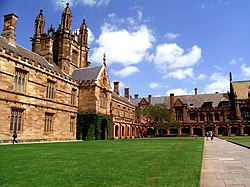Other controversies
In 1945, the Christian Societies of the university drew media attention after they called for the paper's editors to be sacked for publishing information about birth control, and for misquoting the Bible. [43] These complaints were supported by the then Rector of St John's College who suggested its distributors be arrested, though police did not pursue the matter. [44]
In 1950, printers Consolidated Press refused to produce an edition of Honi due to an article relating to an employee of the Commonwealth Police (now the Australian Security Intelligence Organisation and the Australian Federal Police), for fear it constituted a breach of national security. [45]
In 1952, fights broke out at Sydney University, including in the Honi Soit office, after the newspaper published reports of drunkenness and savage hazing rituals at the university's ecclesiastical colleges. The brawls were caused by members of the colleges attempting to remove the paper from circulation, going so far as to chase a truck delivering copies out of the university grounds. Police were eventually called in to control the situation. [46] [47]
In 1970, Honi published confidential intelligence files that showed the Australian Security Intelligence Organisation had blocked the appointment of one of its former editors, Hall Greenland, from a job in the public service. [48] Greenland went on to become a Walkley Award-winning journalist.
Honi Soit was frequently in conflict with the police from the 1950s through to the 1970s for publication of what was considered indecent material, generally depicting nudity or erotica in various forms, often published to specifically antagonise the authorities. [22] Having won over public opinion by the mid 1970s, Honi continued its practice of occasionally featuring nudity up until the 1990s with little interference. [10]
In 1995, the editors (including The Chaser's Charles Firth) used their colour pages to create an advertisement for Union Board candidate Nick Purtell. The editors were fined $360 (the cost of an advertisement) and asked to apologise for the misuse of advertising space. The editors printed an apology in size 4 font, then ran a full page ad in support of their actions. Mr Purtell did not manage to get elected. [10] This incident was recalled by Charles Firth in the ABC documentary Uni. [49] [50]
In 1995, Honi Soit reprinted a controversial article from Rabelais Student Media , its La Trobe University counterpart, entitled "The Art of Shoplifting"—one of seven student newspapers to do so in the wake of Rabelais editors being prosecuted by state censors.
In their last edition for 2005, the editors produced "Hx", an imitation of the free "Mx" tabloid. They used their colour pages to present a biting satire of quality commercial media, with rarely seen images of dead and wounded Iraqis juxtaposed against vacuous magazine style copy, such as "Fashion From the Front Line". The inclusion of images of dead and mutilated civilian casualties shocked many readers. [10] This same year the paper was accused of having turned from its radical roots by comedian Jonathan Biggins after it published a critical recap of his Wharf Revue. [51]
De-classified U.S. National Security Agency documents were published by Honi in 2013, which showed the paper had been suspected by intelligence agencies of operating under Soviet influence. [52]
In 2016, the editors produced a satire spoof of broadsheet newspaper The Australian for their last edition for the year. The issue, complete with replica masthead, featured a front-page splash about Rupert Murdoch dying and satirical parody opinion pieces from journalists at the paper. [53] [54] [55] The prank was acknowledged by The Australian's CEO Nicholas Gray. [56]
On Tuesday 16 May 2023, hundreds of copies of Queer Honi, the annual autonomous edition of Honi Soit produced by the Queer Action Collective, were stolen from stands. Hundreds more were taken the following day. Honi Soit estimated that nearly a thousand copies were stolen, almost half of the paper's print run. Honi noted that "With the paper's masthead being "Fagi Soit" and featuring a cover image of a trans woman's torso tattooed with slurs, the theft is, in Honi's view, a targeted attack against queer expression". [57]
In June 2025, Honi Soit withdrew an invitation to news.com.au political editor Samantha Maiden, who had been scheduled as a keynote speaker for its Student Journalism Conference in August of that year. The editors told her by email that they had "received community concerns" about Maiden's "political coverage and reporting" on the Gaza war. Maiden penned an article on the experience in response. [58] [59] Following Maiden's removal, journalist David Marr withdrew from the event in solidarity, expressing concern about the exclusion of differing perspectives from the conference. [60] Honi Soit editor Mehnaaz Hossain responded to the controversy in an October 2025 piece, writing that "Honi does not believe in platforming those who contribute to the institutional failure to speak up for Palestine." [61]



